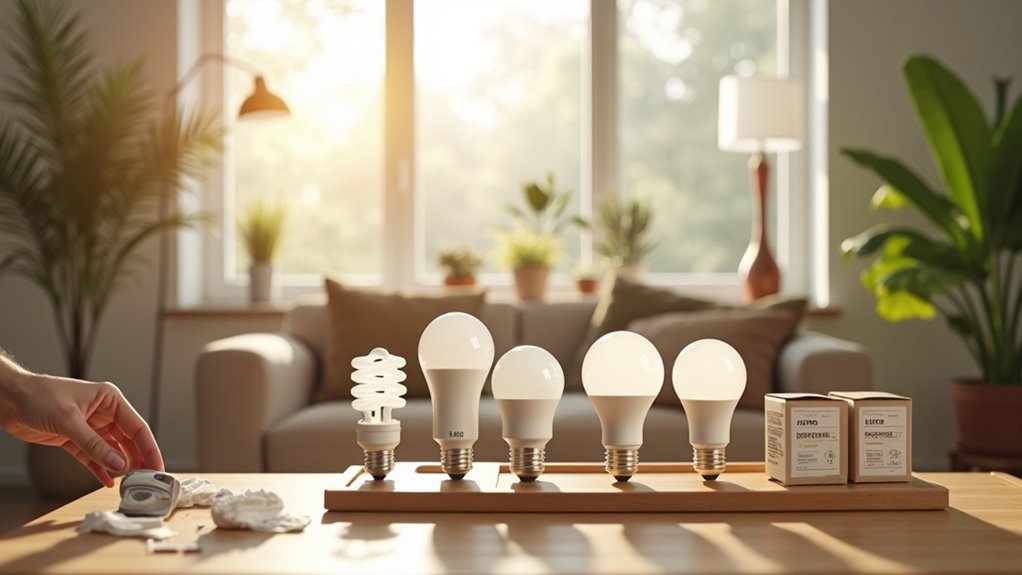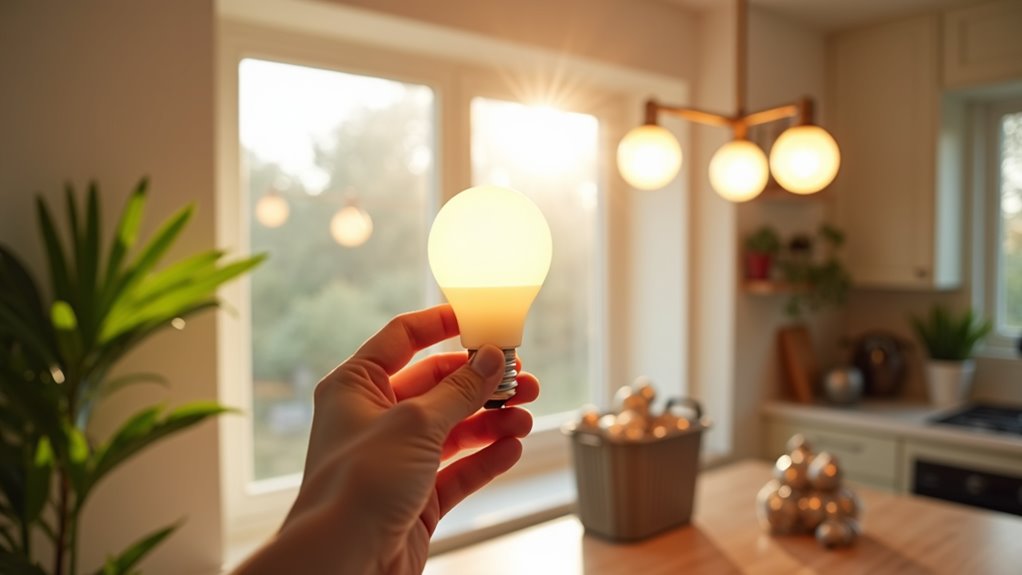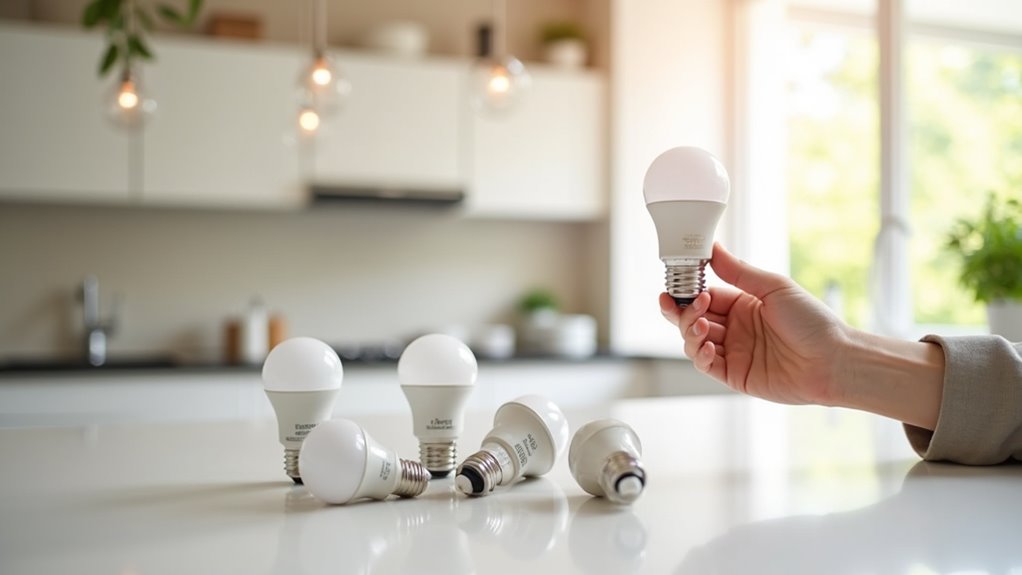Choosing Title 20 compliant light bulbs is crucial for California homeowners aiming to enhance energy efficiency. These bulbs meet strict performance standards, including minimum efficacy levels of 45 lm/W for general service lamps and 80 lm/W for LED alternatives. Lifespan requirements range from 1,000 to 25,000 hours, providing long-term savings. Important features include a color rendering index of at least 80 and specific brightness standards. Understanding these criteria ensures informed decisions, revealing further advantages and types of compliant bulbs available.
Key Takeaways
- Check the Modernized Appliance Efficiency Database System (MAEDBS) to find compliant light bulbs for your home.
- Ensure general service lamps (GSLs) have at least 45 lm/W efficacy and SLEDs at least 80 lm/W.
- Look for bulbs with a color rendering index (CRI) of 80 or higher for better color quality.
- Select bulbs with lifespans of 1,000 hours for GSLs and at least 10,000 hours for SLEDs.
- Verify that bulbs meet electrical performance standards, such as a power factor greater than 0.7.
Understanding Title 20 Lighting Standards

Although Title 20 lighting standards primarily aim to enhance energy efficiency in California, they are governed by the California Energy Commission (CEC) and mandate minimum energy efficiency levels for various lighting products. These Title 20 regulations target specific categories, including state-regulated LED lamps, small diameter directional lamps, and general service lamps, covering both residential and non-residential applications. Products must be compliant and listed in the Modernized Appliance Efficiency Database System (MAEDBS) to be legally sold. The regulations evolved through phases, with stringent requirements introduced in Tier I and Tier II, enhancing efficacy and the Color Rendering Index. To ensure compliance, products must meet specified performance standards associated with energy efficiency. Additionally, products must undergo testing to verify their compliance before market entry.
Key Performance Requirements for Title 20 Bulbs

To ensure compliance with Title 20 lighting regulations, light bulbs must meet specific key performance requirements that encompass luminous efficacy, color quality, lifespan, electrical performance, and light distribution. The following table summarizes these criteria:
| Performance Aspect | Requirement | Notes |
|---|---|---|
| Luminous Efficacy | Minimum 45 lm/W for GSLs; 80 lm/W for SLEDs | Brightness levels specified |
| Color Quality | CRI ≥ 80 for non-modified spectrum lamps | Compliance scores for SLEDs required |
| Lifespan Durability | Minimum 1,000 hours for GSLs; 10,000 for SLEDs | Reduces waste and replacement costs |
| Electrical Performance | Power factor > 0.7; standby power ≤ 0.2 watts | Low flicker for dimmable lamps |
| Light Distribution | Must meet ENERGY STAR® requirements | Specifications vary by lamp type |
These requirements ensure efficient, durable, and quality lighting solutions.
Identifying Title 20 Compliant Bulbs

Identifying Title 20 compliant light bulbs requires an understanding of specific regulations and characteristics that distinguish compliant products from non-compliant alternatives.
Essential for compliance verification is consulting the Modernized Appliance Efficiency Database System (MAEDbS), where only compliant bulbs are listed.
Additionally, bulb selection should focus on markings indicating Title 20 adherence, which must display the manufacturer’s name, model number, and production date.
Key characteristics include efficacy levels—General Service Lamps (GSLs) requiring a minimum of 45 lm/W, while State-Regulated LED Lamps (SLEDs) demand at least 80 lm/W.
Furthermore, compliant bulbs often exhibit a correlated color temperature between 2200K and 7000K, meeting specific brightness and color rendering index standards.
Benefits of Choosing Title 20 Bulbs

Choosing Title 20 compliant light bulbs yields significant benefits, particularly in terms of energy efficiency, cost savings, and environmental responsibility.
Opting for Title 20 compliant light bulbs enhances energy efficiency, saves money, and promotes environmental responsibility.
By adhering to the standards set by the California Energy Commission, homeowners can enjoy:
- Energy Efficiency: Title 20 mandates minimum efficacy levels for light bulbs, ensuring optimal lumens per watt (LPW) performance.
- Cost Savings: Reduced energy consumption translates to lower electricity bills, with compliant bulbs often lasting 10,000 to 25,000 hours, further minimizing replacement costs.
- Environmental Impact: Lower energy use decreases greenhouse gas emissions and waste production, supporting sustainability.
These advantages underlie the appeal of Title 20 compliant bulbs, making them a smart choice for consumers looking to enhance their energy efficiency and realize significant cost savings.
Common Types of Title 20 Compliant Bulbs

Title 20 compliant light bulbs encompass a variety of types designed to meet specific energy efficiency standards mandated by California regulations. This classification includes State-Regulated LED Lamps (SLEDs), General Service Lamps (GSLs), Small Diameter Directional Lamps (SDDLs), and Title 20 Compliant Smart Bulbs. Each type complies with stringent requirements focusing on luminous efficacy and lifespan, primarily leveraging LED technology.
| Bulb Type | Minimum Efficacy (lm/W) | Lifespan (Hours) |
|---|---|---|
| State-Regulated LED Lamps | 80 | 25,000 |
| General Service Lamps | 45 | 1,000 – 25,000 |
| Small Diameter Directional Lamps | 70-80 | 25,000 |
| Title 20 Compliant Smart Bulbs | Meets Lamp Type Standards | Varies |



Bài viết cùng chủ đề:
Top 5 Security Flood Light Bulbs for Protecting Your Home
Top 3 LED Office Light Bulbs for Bright Workspaces
Top 5 PAR 20 LED Light Bulbs for Home Lighting
What Are Linear Halogen Light Bulbs and How Do They Function?
5 Best Battery-Operated LED Picture Lights for Artwork in 2025